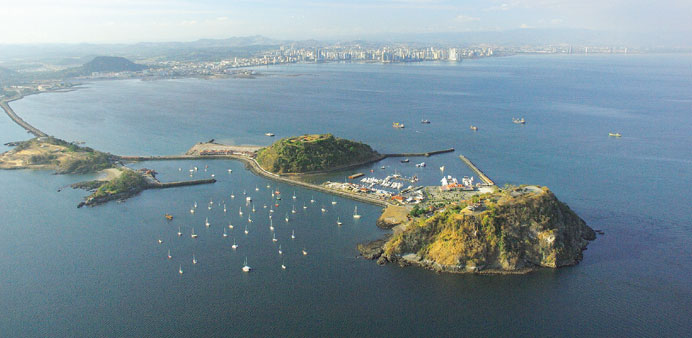PICTURESQUE: The Amador Causeway (left), a road from Panama City to islands offshore in the Pacific Ocean. Cruise passengers love to photograph the link.
By Christina Horsten
A pair of binoculars is vital for a trip through the Panama Canal, still a wonder of the world in engineering terms, 100 years after its completion.
The waterway connecting the Atlantic and Pacific is embedded in a fascinating landscape.
In the early-morning mist, the glittering skyline of Panama City on the Pacific coast looms large on the horizon. Although the sun has just tentatively risen, the ambient temperature is already up to 30 degrees Celsius.
It’s humid here. Dozens of perspiring passengers on this cruise are up on the deck of the Island Princess already, craning their necks for a glimpse of the city which marks the start of their passage.
These travellers came aboard in Los Angeles around a week ago and have already stopped over in Mexico, Nicaragua and Costa Rica, but this is the highlight of the cruise - a trip along The Panama Canal was inaugurated on August 15, 1914 when the first vessel with 200 people on board made a journey through the newly completed waterway.
As the cameras click, a cheery voice booms from a loudspeaker. “Good morning! I hope you have a great day in the Panama Canal,” says Bill Keene, a retiree from southern California. Bill worked for many years as an architect and engineer.
Today he is employed as one of the experienced guides who keep up a running commentary for cruise ship tourists passing through the canal.
The Panama City skyline draws closer as the ship passes the Amador Causeway, a road across the water to a couple of islands in the Pacific.
At this point a small boat approaches the cruise ship with three Panamanian pilots on board. Their task is to assist the man in charge on the bridge of the liner, Italian captain Mariano Manfuso.
The vessel heads for the first of three locks and follows a green arrow which allocates it the left-hand channel.
The French planned to build the Panama Canal at sea-level throughout, but Panamanian topography put paid to that idea.
In the course of the 82-kilometre waterway, ships have to work their way to the highest section of the canal through a series of locks which lift them from sea level to an altitude of 26 metres at Gatun Lake.
Just before the ship reaches the Miraflores lock, around 30 stevedores swarm on board to attach mooring ropes to a set of eight locomotives. These manoeuvre the ship into the locks before these are raised or lowered.
The engines are called mules, because the work used to be performed by live mules.
This vessel is a tight fit, with just six centimetres’ clearance between the hull and the lock wall. It’s a huge responsibility and captain Manfuso admits that he sometimes loses sleep at night worrying about it.
The next lock, Pedro Miguel, precedes the Culebra Cut, the highest section of the canal.
Digging through the mountains of Panama at the highest point posed a challenge to the canal engineers. The area is still prone to landslides and the channel has to be constantly dredged in order to keep it open to traffic.
After the Culebra Cut the cruise ship enters Gatun Lake. This is the tranquil part of the tour.
The greeny-blue surface of the lake is dotted with numerous forest-clad islets — remains of the dense rainforest that once covered these parts. Before the area was flooded and became a lake, these were the tops of hills.
By this time a lot of passengers have gone back to their cabins or are tucking into the poolside buffet.
“We do some special Panamanian recipes on board such as cakes or desserts made with rich creamy milk rather than eggs,” said the German chef in charge Guido Jendrytzko. “For us in the kitchen, this is the most exhausting day of the entire trip.”
Most of the crew have been on this transit trip dozens of times before and regard it as routine. “Once you’ve seen it, you’ve seen it,” said fitness trainer Lischka. Waiter Enrique, who hails from the Philippines, does not bother to go up on deck during the passage. “I don’t really like the canal. Way too hot, just like at home.”
Many of the passengers, especially North Americans, have personal links to former Panama Canal staff and they are thrilled to be here.
“This is incredible, just the mechanics and the way they figured out how to do this is amazing and the fact that 100 years later it is still working the way they planned it and the size of the ships: it’s unbelievable.
“It’s like an eighth wonder of the world,” says Dan Keily, a passenger.
The vessel has since entered the home straight. Only the Gatun Locks separate it from the salty water of the Atlantic Ocean. Most of the travellers throng the decks in order to watch the precision manoeuvring as the vessel painstakingly maintains its position.
The white hull of the ship does have a few black stress marks, so-called “Panama stamps,” to show for its scrapes along the lock-side. The rubbings will be painted over when the ship undergoes its next maintenance.
“I think it’s about time I stopped doing all the talking,” says canal expert Keene through the loudspeakers.
“I hope you enjoyed your day in Panama. I have and it’s my favourite day of this cruise. It marked my 29th transit and every one of them has been different. Every one of them has been memorable.” —DPA
BELOW:
TIGHT FIT: The Miraflores Locks on the Panama Canal.

